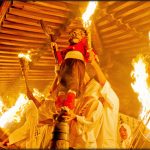Gero’s Ryujin Fire Festival is an extraordinary event in Gifu Prefecture, celebrated annually from August 1st to 3rd. This lively festival combines traditional Japanese folklore with modern entertainment, attracting visitors from all over Japan and beyond.
The festival is deeply rooted in local legends, particularly the story of “Wankasebuchi.” According to this legend, five dragons (Ryujin) are integral to the cultural fabric of Gero. These dragons are believed to possess mystical powers and play a central role in the festival’s events. The celebration honors these mythical creatures and their importance in local folklore, blending spiritual reverence with festive activities.
Ryujin Fire Festival Highlights
- August 1st: Dragon Dance on Shirasagi Bridge
The festival starts with a spectacular performance featuring five dragons making their way through the city. The highlight of this day is the dragon dance on the Shirasagi Bridge. The dragons perform intricate and original dances amidst sparks and flames, creating a mesmerizing spectacle against the night sky. This event showcases the dance’s beauty, skill, and coordination to safely handle dragons and pyrotechnics. - August 2nd: Mikoshi Parade and Samba Dancing
The energetic mikoshi (portable shrine) parade marks the second day. Groups of enthusiastic participants carry these shrines through the streets of Gero. Adding to the excitement are samba dancing teams in bright, colorful costumes who follow the mikoshi, infusing the traditional procession with a lively, rhythmic beat. This fusion of cultural elements highlights the festival’s unique blend of old and new. - August 3rd: Grand Fireworks Display
The final day of the festival culminates in a grand fireworks display. Brilliant fireworks are launched into the sky, synchronized with musical accompaniment. This dazzling display lights up the night, creating a stunning visual and auditory experience. Dancers once again take to the streets, adding to the festive atmosphere. The fireworks and dancing together make for a memorable conclusion to the three-day celebration.
Gero Onsen
Gero is 90 minutes from Nagoya and an hour south of Takayama. It is known as one of Japan’s most famous spa towns. The Confucian poet Hayashi Razan recognized it as one of the country’s top three onsens. In town, there are three public bathhouses where you can enjoy the healing waters. At the south end of the Gero Bridge, there is a large ‘rotenburo’ (open-air bath) where you can bathe for free; however, it has no facilities and is exposed to the bridge above. In Gero, many Japanese hotels, known as ‘ryokan,’ offer bathing facilities, some with private baths that can be shared with friends or family members of mixed sexes. However, the regular communal onsen baths in Gero, like most of Japan, require separating men and women. Most of these ryokan also offer lunch and bathing packages, where you can dine in a private room before soaking in the steamy waters. Gero has the perfect solution if you’re uncomfortable with disrobing but still want to experience the therapeutic waters. ‘Ashiburo’ (foot baths) are scattered throughout the city, offering a comforting and free foot-soaking experience. This is especially helpful during winter when your feet are freezing as they do. These foot baths provide relief and relaxation, ensuring comfort during your visit to Gero.
Around Gero City
Onsenji Temple, with its serene atmosphere and historical significance, is a spiritual retreat and a place steeped in legend. The temple’s main deity, Yakushi Nyorai, is revered as the Buddha of healing, and the story of the temple’s image restoring hot spring water after an earthquake adds to its mystical allure. Visitors who climb the long stone staircase are often rewarded with tranquility and a stunning view of the city and the Hida River, making the journey well worth the effort.
In addition to its spiritual and scenic offerings, Onsenji Temple hosts various annual events and festivals, such as the Onsenji Temple Spring Festival. During this time, the temple grounds are adorned with cherry blossoms, creating a picturesque and festive atmosphere that attracts locals and tourists.
Gero Onsen Gassho Mura is more than just an open-air museum; it is a living testament to the region’s cultural heritage. The traditional gassho-zukuri houses, characterized by their steep thatched roofs, are architectural marvels designed to withstand heavy snowfall. Some over 200 years old, they have been relocated from the Shirakawago region, a UNESCO World Heritage site, to preserve and showcase their unique construction.
The museum offers hands-on experiences, such as indigo dyeing and ceramic painting, allowing visitors to engage with traditional crafts. Seasonal events, such as the Gassho Mura Winter Illumination, light up the village, providing a magical nighttime experience. The museum also features live performances of traditional music and dance, bringing the area’s cultural history to life.
A fascinating cultural tidbit about Gero is its name, which mimics the sound Japanese people associate with frogs (‘gero gero’). This whimsical connection is celebrated throughout the city with adorable frog motifs. Frogs are considered good luck symbols, and their depictions can be found in various forms, from statues in parks to intricate designs on manhole covers. The city even has a mascot, Gero-Kun, a charming frog character that delights visitors, especially children.
Moreover, Gero Onsen itself is one of Japan’s top three hot spring resorts, alongside Arima Onsen and Kusatsu Onsen. The hot springs here are known for their therapeutic properties, particularly for skin ailments. The town offers several public bathhouses and ryokan (traditional Japanese inns) where guests can enjoy private onsen baths. Some ryokan also provide open-air baths with scenic views, enhancing the relaxation experience.
For those interested in culinary delights, Gero Onsen is famous for its Hida beef, a high-quality wagyu beef from the Hida region. Many local restaurants offer this tender and flavorful meat, from traditional sukiyaki to grilled steaks. Combining a hot spring soak and a sumptuous meal makes for a perfect day in Gero.
In summary, Gero Onsen and its surrounding attractions offer a rich blend of cultural heritage, natural beauty, and modern comforts. Whether seeking spiritual solace at Onsenji Temple, a cultural immersion at Gassho Mura, or simply a relaxing soak in the hot springs, Gero has something to offer every visitor.
Gero Station
Koden, Gero, Gifu 509-2206 (map)
Suikotei, CC BY-SA 4.0, via Wikimedia Commons





